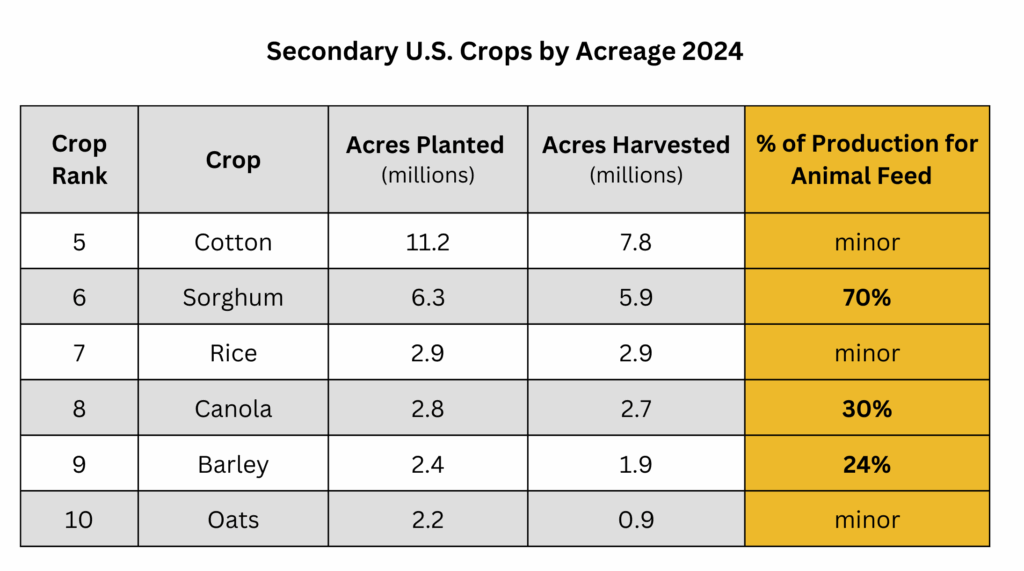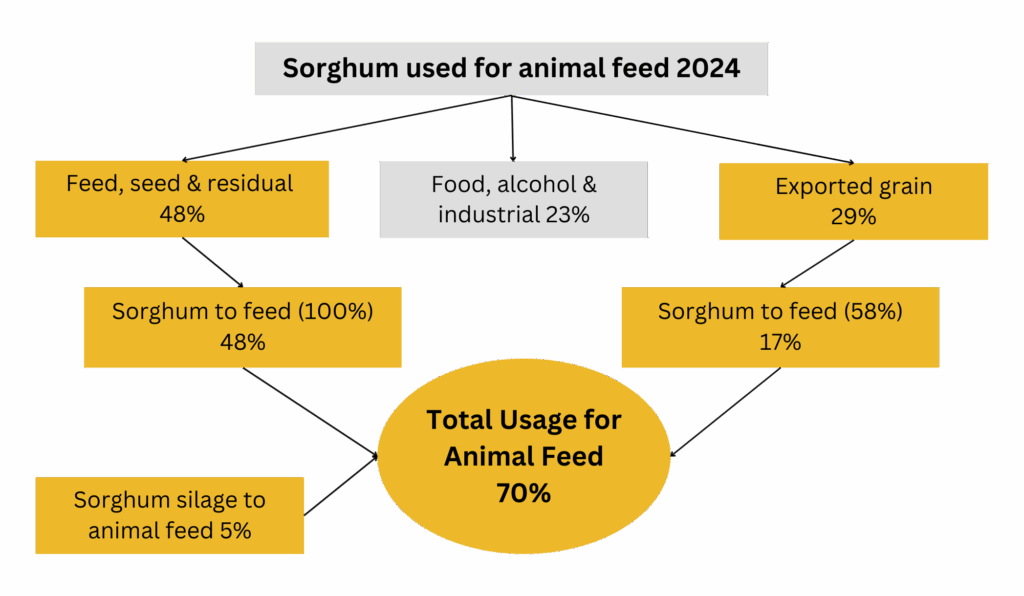
USDA NASS (June 2025) Acreage, ISSN: 1949-1522, p. 32.
For Animal Feed Usage, sources are noted below with calculations relying primarily on USDA data. Figures are based on percent of “disappearance” – the utilization of a crop or product, e.g., food, industrial use, exports. [USDA NASS (1999) Understanding USDA Crop Forecasts, No. 1554, p. 9]
Although not commonly understood, cottonseed and cottonseed meal are popular feeds for dairy and beef cattle producers.[1,2] One research and marketing company for the cotton industry stated that “…more than 50% of the annual supply of whole cottonseed is consumed by dairy cattle.”[3] In California, “over 95%” of cottonseed is fed to dairy cattle.[4] As of 2024, about 21% of the value of cotton production is in cottonseed.[5]
We do not have current data on the share of cottonseed used nationally for animal feed, however. A broad estimate is that about 5-10% of the total value of cotton production goes to animal feed, though it is not included in our final tallies of feed crop usage.[6]
Stewart, L., & Rossi, J. (2010). Using cotton byproducts in beef cattle diets, Univ. of Georgia Extension, Bulletin 1311. [“Cottonseed, cottonseed meal and cottonseed hulls are widely used as feed ingredients in beef cattle diets.”]
Ely, L. O., & Guthrie, L. D. (2008). Feeding whole cottonseed to dairy cows and replacements, Univ. of Georgia Extension, Special Bulletin 59. [“Whole cottonseed is a popular feed for dairy producers.”]
Cotton Incorporated (2010) Whole Cottonseed – A Super Feed for Dairy Cows. https://www.cottoninc.com/cotton-production/ag-research/cottonseed/whole-cottonseed-a-super-feed-for-dairy-cows/ [“In fact, more than 50% of the annual supply of whole cottonseed is consumed by dairy cattle.” This would more-or-less equal 10% of the cotton crop value (19% x 50%), which when added to meal usage could be well above 10%. While acknowledging the large amount of acreage and likely significant value of feed, we estimate the usage as “minor” and do not include in our total feed crop calculations due to lack of firm data.]
California Cotton Ginners & Growers Association (n.d.) CA Cotton Facts. https://ccgga.org/cotton-information/ca-cotton-facts/ [“California’s production represents approximately 7% of U.S. total annual cottonseed production on average. Over 95% is fed to dairy cattle and the balance is crushed for the oil…Cottonseed hulls are mainly used for animal feed… The cottonseed meal and cake is used for fertilizers and feed for cattle, sheep, horses, pigs, fish and shrimp.”]
USDA NASS (2025) Crop Values 2024 Summary, ISSN: 1949-0372, pp. 29-30. [[Cottonseed value = $998,681,000; Cotton value = $4,674,379,000. Share of cottonseed == 21.4%]
USDA NASS (2021) Agricultural Statistics 2021, table 1-72, p. I-40. https://downloads.usda.library.cornell.edu/usda-esmis/files/j3860694x/gq67m183k/np194m208/2021_Agricultural_Statistics_Book.pdf [In 2019, total cottonseed weight was 5,945 million tons and total disappearance for commercial feed was 2,258 million tons of cottonseed cake or meal, or about 38% of the volume of cottonseed.]
In 2024, about 70% of sorghum went to animal feed. It is the second largest grain crop used for animal feed, after corn.

Feed and residual use was ~48% of total disappearance.[1]
Exports were ~29% of total disappearance. The top 3 markets for sorghum constituted more than 99% of total exports.[2] Those 3 markets used roughly 58% of its sorghum for feed, making exported sorghum for feed ~17% of total disappearance.[3]
Silage made up ~5% of sorghum usage. This figure is based on the percentage of acres of silage harvested to the total acres harvested for both silage and grain.[4] The USDA tallies sorghum silage separately from grain disappearance presumably since the end-product (tons of silage) is not comparable to bushels of sorghum.
USDA Economic Research Service, Feed Grains Yearbook Tables, table 5 (updated 8/13/25): Sorghum: Supply and disappearance, MY 2024/25. [feed and residual use = 155 million bushels / total disappearance of 325 million bushels = 47.7%]
Feed Grains Yearbook Tables, table 22: U.S. corn and sorghum exports by selected destinations, MY 2024/25. [[top 3 import markets = 5.88 million tons / total exports = 5.95 million metric tons == 98.94% for top 3 markets]
USDA Foreign Agricultural Service, Production, Supply and Distribution (PS&D) database, reporting period August 2025 for year 2024. [Analysis: a) Graphical queries for top 3 markets, calculating sorghum “feed waste domestic consumption” as a percentage of “total domestic consumption” 2024. b) Weighting the percentage of feed waste domestic consumption by country]
USDA NASS (June 2025) Acreage, ISSN: 1949-1522, Crop Area Planted and Harvested, Yield and Production in Domestic Units – United States: 2024, p. 32. [Sorghum harvested for silage = 306,000 acres / Sorghum acres harvested for grain (5,605,000) plus harvested for silage (306,000) = 5,911,000 acres. Silage share == 5.18%]
In 2024, sorghum was planted on 6.3 million acres and harvested for grain on ~89% of that area (5.6 million acres). About 5% of planted acres were harvested for sorghum silage (306,000 acres).[1]
Much of the unharvested acreage was likely used to graze livestock directly, though the USDA does not estimate that usage, and we do not include it in our tallies.[2,3]
USDA NASS (June 20245 Acreage, ISSN: 1949-1522, Crop Area Planted and Harvested, Yield and Production in Domestic Units – United States: 2024, p. 32. [Harvested silage includes the plant with the grain.]
Dahlke, G. R. (2022). Swath Grazing Forage Sorghum and Pearl Millet Observations Regarding Quality and Utilization as Winter Feed. Iowa State University Animal Industry Report 2021, 17(1):15553.
Feedipedia, Animal feed resources information system, Sorghum forage. [“Forage sorghum can stand heavy grazing. Rotational grazing is the safest way of utilizing the pasture to provide maximum nutrition.”]
In 2024, about 24% of barley was used for animal feed.[1] Barley grain is used as a protein source in beef cattle diets.[2,3]
USDA Economic Research Service, Feed Grains Yearbook Tables, table 6 (updated 8/13/25): Barley: Supply and disappearance, MY 2024/25. [domestic feed & residual = 38 million bushels / total disappearance = 161 million bushels == 23.48%. In 2023, ~31% was used for domestic animal feed.]
North Dakota State Univ. (2017) Barley Grain and Forage for Beef Cattle, AS 1609. https://www.ndsu.edu/agriculture/sites/default/files/2022-07/as1609.pdf
Cotton Incorporated (2010) Whole Cottonseed – A Super Feed for Dairy Cows. https://www.cottoninc.com/cotton-production/ag-research/cottonseed/whole-cottonseed-a-super-feed-for-dairy-cows/ [See, sample rations for Washington and California].
In 2024, barley grain was planted on 2.4 million acres and harvested on 1.9 million acres.[1] It is also used as pasture, hay, or silage for animal feed, which may account for much of the 498,000 unharvested acres.[2,3]
USDA NASS (June 2025) Acreage, ISSN: 1949-1522, Crop Area Planted and Harvested, Yield and Production in Domestic Units – United States: 2024, p. 32.
Oregon State Univ. Forage Information System (2023) Barley x Elyhordeum Barley Mansf. ex Zizin & Petrowa. https://forages.oregonstate.edu/forages/barley# [“Barley is an annual cereal, a cool-season grass species used for both grain and forage including pasture, hay, silage, and after-grain-harvest straw.”]
North Dakota State Univ. (2017) Barley Grain and Forage for Beef Cattle. https://www.ndsu.edu/agriculture/sites/default/files/2022-07/as1609.pdf
In 2024, oats fed to animals made up ~43% of total usage.[1] The major use of this grain is in the equine market, though it is also used in livestock feed.[2] Feeding programs for younger cattle often include oats as they have a lower potential for causing bloat and other digestive issues.[3,4]
Oats are also grown as a forage crop or for silage which may account for much of the 1.3 million unharvested acres.[5,6] Since we have no data specifically on farmed animal feed usage, we are not including oats in final tallies of total usage for animal feed.
USDA Economic Research Service, Feed Grains Yearbook Tables, table 7: Oats: Supply and disappearance, MY 2024/25. [Feed & residual = 62 million bushels / domestic disappearance = 146 million bushels == 42.5%]
Decision Innovation Solutions (February 2025) Animal Feed Consumption. Report prepared for IFEEDER and American Feed Industry Assoc., Table 6.1, pp. 78-79.
Penn State Extensions (2022) Feeding Small Grains to Beef Cattle. https://extension.psu.edu/feeding-small-grains-to-beef-cattle
Beef-Cattle Extension (2019) Can I use oats as a feed for beef cattle? https://beef-cattle.extension.org/can-i-use-oats-as-a-feed-for-beef-cattle/
Kubesch, J., et al., (n.d.) Planting Oats for Forage. Univ. of Arkansas, Division of Agriculture. https://www.uaex.uada.edu/publications/pdf/FSA3151.pdf [“Oats are fast-growing small grains that have long been used for grazing, hay and silage. Oats can be used to fill forage gaps in either spring or fall. They are popular for grazing in fall or as a hay crop in spring.”]
Mike Rankin (2025) Oats Offer a Valuable Fall Forage Alternative. Ohio State Univ. College of Food, Agricultural & Environmental Sciences. [“What is most impressive about fall-grown oats is its harvest versatility. Chopping for oatlage, baleage, or grazing are all viable options.”]
In 2024, oats were planted on 2.2 million acres and harvested as grain on 886,000 acres, or ~40% of acres planted.[1]
Much of the unharvested acres (~60%) were likely used as forage or hay.[2-4]
USDA NASS (June 2025) Acreage, ISSN: 1949-1522, Crop Area Planted and Harvested, Yield and Production in Domestic Units – United States: 2024, p. 32.
USDA (2006) Illinois Grazing Manual Fact Sheet: Oats for Fall/Spring Grazing. https://www.nrcs.usda.gov/sites/default/files/2022-09/OatsForFall-SpringGrazing.pdf
Oklahoma State Univ Extension (2017) Spring-Planted Oat for Grazing or Hay Production, https://extension.okstate.edu/fact-sheets/spring-planted-oat-for-grazing-or-hay-production.html
Mike Rankin (2025) Oats Offer a Valuable Fall Forage Alternative. Ohio State Univ. College of Food, Agricultural & Environmental Sciences.
In 2024, about 30% of canola seed by value went to animal feed.
Most canola seed was used for crush (~80%).[1] From the crush the accepted ratio of oil to meal by weight is about 45% oil and 55% meal.[2,3] However, in 2024 the value of the meal was ~37% of the combined value of oil and meal.[4] Almost all canola meal goes to animal feed.[5]
Using the percentage going to crush (~80%) times the relative value of canola meal (~37%) times the amount going to animal feed (100%) points to ~30% of canola seed going to animal feed.
USDA Economic Research Service, Oil Crops Yearbook, Canola Seed and Canola Seed Products, table 25 (updated 3/20/25). [Canola seed used for crush = 4,530 million lbs. / total disappearance = 5,630 million lbs. == 80.46%. Although the data was updated in March of 2025, it is footnoted as “Forecast.” The calculations do not consider imports; since we are not calculating final weights, but rather percentages of usage, we assume that imports have similar usage patterns to domestic production. Canola seed imports are ~12% of total supply.]
U.S. Canola Association, Seed, Oil and Meal, https://www.uscanola.com/crop-production/seed-meal-and-oil/ [Each seed contains about 45 percent oil…Canola meal is one of the most widely used protein sources in feed for livestock, poultry and fish.”]
Feedipedia, Rapeseed meal, https://www.feedipedia.org/node/52 [“Rapeseeds contain 40-45% oil and yield about 55-60% oil meal when fully extracted by crushing followed by solvent extraction.”
USDA Economic Research Service, Oil Crops Yearbook, Canola Seed and Canola Seed Products, table 26 and table 27 [Canola meal production = 2,892 billion pounds * .197 cents per pound ($285 per ton). Canola Oil Production = 1,936 billion pounds * .50 cents per pound. $569,724,000 / $1,537,724,000 = 37%.]
USDA Foreign Agricultural Service, Production, Supply and Distribution (PS&D) database, reporting period August 2025, for year 2024. [Graphical query for rapeseed meal, United States, Feed Waste domestic consumption is equal to total domestic consumption (4,743,000 metric tons)]
In 2024, canola was planted on 2.8 million acres and harvested for canola seed on 2.7 million acres, or ~96% of acres planted.[1]
USDA NASS (June 2025) Acreage, ISSN: 1949-1522, Crop Area Planted and Harvested, Yield and Production in Domestic Units – United States: 2024, p. 32.
In 2024, feed and residual use for rye as a grain (the 10th largest crop by acres planted was ~19% of total disappearance.[1] The vast majority of planted rye is unharvested (~82% of planted acres).[2] Many of these unharvested acres are used as pasture for grazing, with some rye grasses cultivated primarily for pasture.[3,4]
About 37% of sunflower seeds was used for crush.[5] The crush generates both oil and coproduct sunflowerseed meal. The meal goes to animal feed.[6]
Many other crops have common uses as animal feed, including barley, sugar beets, millet, and others.[7]
We do not include any of these uses in our final tallies, since there is not enough data to quantify shares of total acreage.
USDA, Wheat Data-Recent, table 12 (updated 8/13/25): Rye: supply and disappearance, MY 2024/25. [Feed & residual = 4.32 million bushels / total disappearance = 23.25 million bushels == 18.58%]
Wheat Data-Recent, table 2, Rye: planted acreage, production, yield, MY 2024/25. [planted acreage 2,206,000 acres. Harvested acres = 402,000, accounting for ~18% of planted acres]
Mississippi State Univ. Extensions (2020) Annual Ryegrass—Staple for Winter Grazing in the South, Forage News. https://extension.msstate.edu/newsletters/forage-news/2020/annual-ryegrass-staple-for-winter-grazing-the-south
Yoana Newman, Univ. of Wisconsin-Madison, Ryegrasses for Pastures, Crops and Soils. https://cropsandsoils.extension.wisc.edu/articles/ryegrasses-for-pastures/
USDA Economic Research Service, Oil Crops Yearbook, Sunflowerseed: U.S. supply, disappearance, and price, 2024/25 (forecast), table 22 (updated 3/20/25). [Sunflower seed used for crush = 694 million lbs. / total disappearance of 1,876 million lbs. == 36.99%.]
USDA Foreign Agricultural Service, Production, Supply and Distribution (PS&D) database, reporting period August 2025, for year 2024. [Graphical query for sunflowerseed meal, United States, Feed Waste domestic consumption is equal to total domestic consumption (157,000 metric tons). Additionally, about 10% of U.S. sunflowerseed meal is exported.]
Decision Innovation Solutions (February 2025) Animal Feed Consumption. Report prepared for IFEEDER and American Feed Industry Assoc., Table 6.1, pp. 78-79.
